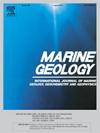Widespread contamination of the Pacific upper mantle during the mid-Cretaceous
IF 2.2
3区 地球科学
Q2 GEOSCIENCES, MULTIDISCIPLINARY
引用次数: 0
Abstract
This study presents new 177Hf/176Hf measurements on variably altered samples from the Early Cretaceous Pacific oceanic crust subducting into the Izu-Bonin trench. The new results are then combined with existing major and trace element and Nd![]() Pb isotopic data to provide further constraints on existing models for the evolution of the Mesozoic Pacific upper mantle. The samples, from an across flow line transect of the oceanic crust accreted along the Pacific-Izanagi ridge system, can be separated into a relatively older (140–127 Ma), mostly normal mid-ocean ridge basalt (N-MORB) group and a younger (<127 Ma) group that includes many enriched (E-)MORBs. The Hf
Pb isotopic data to provide further constraints on existing models for the evolution of the Mesozoic Pacific upper mantle. The samples, from an across flow line transect of the oceanic crust accreted along the Pacific-Izanagi ridge system, can be separated into a relatively older (140–127 Ma), mostly normal mid-ocean ridge basalt (N-MORB) group and a younger (<127 Ma) group that includes many enriched (E-)MORBs. The Hf![]() Nd (±Pb) isotope and alteration-resistant incompatible trace element composition of the older N-MORBs is similar to those of the geochemically depleted Jurassic-Early Cretaceous MORBs and Shatsky-Hess Rise platform lavas. On the other hand, the younger E-MORBs are compositionally similar to those of coeval lavas from Ontong Java, Manihiki and Hikurangi plateaus, which were suggested to be previously con-joined as Ontong Java Nui super oceanic plateau, and Ojin Rise Seamounts, which were suggested to be the younger manifestation of the Shatsky-Hess Rise plume. We propose that the older Pacific-Izanagi N-MORBs originated from a depleted MORB mantle (DMM):FOZO (focal zone) mixed source whereas the younger E-MORBs originated from a DMM:FOZO:EMI (enriched mantle 1) ± high μ (HIMU) mixed source. Our results support the proposed widespread contamination of the Pacific upper mantle by geochemically enriched materials that formed the ancestral Ontong Java Nui plateau starting at ca. 125 Ma.
Nd (±Pb) isotope and alteration-resistant incompatible trace element composition of the older N-MORBs is similar to those of the geochemically depleted Jurassic-Early Cretaceous MORBs and Shatsky-Hess Rise platform lavas. On the other hand, the younger E-MORBs are compositionally similar to those of coeval lavas from Ontong Java, Manihiki and Hikurangi plateaus, which were suggested to be previously con-joined as Ontong Java Nui super oceanic plateau, and Ojin Rise Seamounts, which were suggested to be the younger manifestation of the Shatsky-Hess Rise plume. We propose that the older Pacific-Izanagi N-MORBs originated from a depleted MORB mantle (DMM):FOZO (focal zone) mixed source whereas the younger E-MORBs originated from a DMM:FOZO:EMI (enriched mantle 1) ± high μ (HIMU) mixed source. Our results support the proposed widespread contamination of the Pacific upper mantle by geochemically enriched materials that formed the ancestral Ontong Java Nui plateau starting at ca. 125 Ma.
白垩纪中期太平洋上地幔的大范围污染
本文对早白垩世太平洋地壳俯冲至伊豆-波宁海沟的变变样品进行了新的177Hf/176Hf测量。然后将新结果与现有的主微量元素和NdPb同位素数据相结合,进一步对现有的中生代太平洋上地幔演化模型提供约束。样品来自沿太平洋-伊曲那吉脊系统增生的洋壳横断面,可分为相对较老的(140-127 Ma),主要是正常的洋中脊玄武岩(N-MORB)群和较年轻的(<127 Ma),包括许多富集的(E-) morb。古N-MORBs的HfNd(±Pb)同位素和抗蚀变不相容微量元素组成与地球化学亏缺的侏罗纪-早白垩世MORBs和Shatsky-Hess Rise台地熔岩相似。另一方面,较年轻的e - morb在成分上与Ontong爪哇、Manihiki和Hikurangi高原的同时期熔岩相似,后者先前被认为是Ontong爪哇Nui超级海洋高原,而Ojin Rise海山则被认为是Shatsky-Hess Rise羽流的较年轻表现。我们认为,较老的太平洋-伊札那吉N-MORBs起源于贫MORB地幔(DMM):FOZO(焦点区)混合源,而较年轻的E-MORBs起源于DMM:FOZO:EMI(富地幔1)±高μ (HIMU)混合源。我们的研究结果支持了太平洋上地幔被地球化学富集物质广泛污染的说法,这些物质形成了大约125 Ma开始的古Ontong爪哇Nui高原。
本文章由计算机程序翻译,如有差异,请以英文原文为准。
求助全文
约1分钟内获得全文
求助全文
来源期刊

Marine Geology
地学-地球科学综合
CiteScore
6.10
自引率
6.90%
发文量
175
审稿时长
21.9 weeks
期刊介绍:
Marine Geology is the premier international journal on marine geological processes in the broadest sense. We seek papers that are comprehensive, interdisciplinary and synthetic that will be lasting contributions to the field. Although most papers are based on regional studies, they must demonstrate new findings of international significance. We accept papers on subjects as diverse as seafloor hydrothermal systems, beach dynamics, early diagenesis, microbiological studies in sediments, palaeoclimate studies and geophysical studies of the seabed. We encourage papers that address emerging new fields, for example the influence of anthropogenic processes on coastal/marine geology and coastal/marine geoarchaeology. We insist that the papers are concerned with the marine realm and that they deal with geology: with rocks, sediments, and physical and chemical processes affecting them. Papers should address scientific hypotheses: highly descriptive data compilations or papers that deal only with marine management and risk assessment should be submitted to other journals. Papers on laboratory or modelling studies must demonstrate direct relevance to marine processes or deposits. The primary criteria for acceptance of papers is that the science is of high quality, novel, significant, and of broad international interest.
 求助内容:
求助内容: 应助结果提醒方式:
应助结果提醒方式:


